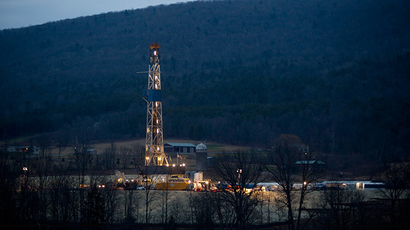Ohio investigation connects earthquakes to fracking

Ohio geologists have linked minor earthquakes in a rock formation underneath the Appalachians to hydraulic fracturing, a first in the state. The finding has caused the state to offer new permit rules for some areas targeted for oil and gas development.
The state investigated five small quakes that occurred last month near Youngstown, finding the hydraulic fracturing, or fracking, process of injecting water and sand into the Utica Shale put pressure on a small fault line, State Oil & Gas Chief Rick Simmers said. He added that the link was “probable,” according to AP.
Simmers said this was the first time tremors in this part of the Appalachian region have been directly associated with fracking. Though he said some quakes in the area had been linked to deep-injection wells that are used to dispose of the massive amount of toxic wastewater the fracking process demands.
To unleash natural gas deep underground, fracking requires large volumes of water, sand, and chemicals to be pumped underground. This process has been linked to groundwater contamination, seismic activity, and other health concerns for humans and the local environment.
Ohio said the company responsible for setting off the tremors – which were not easily noticed by area residents – seems to have followed state rules for fracking.
The Appalachian region – with its gas-rich Marcellus Shale, which sits above the Utica Shale – has been a particular hotbed for fracking activity. Energy companies have drilled thousands of “unconventional gas wells in recent years,” according to AP.
In response to the quake findings, Ohio issued new permits for drilling sites within three miles “of a known fault or seismic activity of 2.0 magnitude or higher.” These sites will be required to have high-tech seismic-monitoring equipment. Regulators will have direct access to any results from the instruments, Simmers said.
If a quake of 1.0 magnitude or higher is detected, drilling at the site will be suspended until further evaluation. If a link between the fracking activity and the tremors is found, the drilling will be put on hold.
Ohio has instituted an indefinite drilling moratorium at the site of the March tremors, while oil and gas extraction has been allowed to continue at five existing wells at the site.
"While we can never be 100 percent sure that drilling activities are connected to a seismic event, caution dictates that we take these new steps to protect human health, safety and the environment," said James Zehringer, director of Ohio's natural resources department.
State regulators all over the US will likely study Ohio’s actions for implications to the industry in general, said Gerry Baker, associate executive director of the Interstate Oil and Gas Commission. Oil and gas drilling has boomed across the US in places with varying rock formations. Thus, Ohio’s findings may not easily translate to other areas where fracking is prevalent.
Meanwhile, geologists have linked an unprecedented spate of seismic activity in Oklahoma to fracking in the state.
In March, it was reported that regulators in Oklahoma, Ohio, Kansas, and Texas discussed how to mutually strengthen fracking standards. According to Bloomberg News, they are also working on establishing similar monitoring procedures across the states that would prevent earthquakes from occurring in the future.














